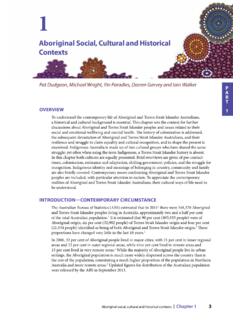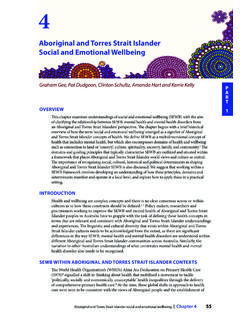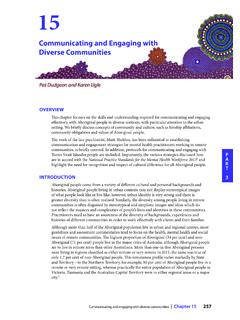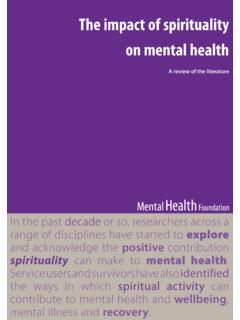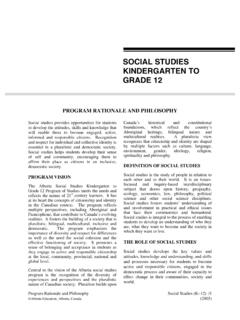Transcription of Social Determinants of Social and Emotional Wellbeing
1 6. Social Determinants of Social and Emotional Wellbeing Stephen R. Zubrick, Carrington CJ Shepherd, Pat Dudgeon, Graham Gee, Yin Paradies, Clair Scrine and Roz Walker OVERVIEW. This chapter explores current understandings of the Social Determinants of Aboriginal and Torres Strait Islander Social and Emotional Wellbeing and its development. We show that the P. Determinants of this Wellbeing are multiple, interconnected, and develop and act across the A. lifecourse from conception to late life. This chapter firstly focuses on the theoretical frameworks R. linking Social factors to health and their applicability in Aboriginal population contexts. It then T. examines how Social and Emotional Wellbeing develops in individuals, with a specific focus on 2.
2 The broad mechanisms that prompt, facilitate or constrain Social and Emotional Wellbeing in all individuals. The chapter then discusses the Social Determinants and processes that pose a risk to the development of poor outcomes among Aboriginal and Torres Strait Islander peoples as well as the factors that promote or protect positive Wellbeing . We highlight that there are a unique set of protective factors contained within Indigenous cultures and communities that serve as sources of strength and resilience. It should be noted that this chapter primarily examines and refers to Social and Emotional Wellbeing ', as opposed to the terms mental health' or mental illness'. The Social and Emotional Wellbeing concept reflects the broader, holistic view of health that is an intrinsic part of Aboriginal and Torres Strait Islander (herein referred to as Aboriginal') culture.
3 It recognises the importance of connection to land, culture, spirituality, ancestry, family and community, and how these affect individual's INTRODUCTION. What can be done to promote and protect the development of optimal Social and Emotional Wellbeing (SEWB) among Aboriginal peoples? How is the development of poor SEWB. prevented or reduced? To begin to address these questions it is necessary to have an understanding of the key Determinants of the Wellbeing of populations. THE IMPORTANCE OF Social FACTORS TO POPULATION HEALTH. The health and development of individuals is shaped by an array of factors over time and by place and lifecourse stage. Genetic history, biology and environmental exposures can all have a marked impact on health, and form part of the complex aetiologies of physical and mental health , 3.
4 In recent decades there has been an increased acknowledgment of the role of Social factors in determining health outcomes. There is now a robust international literature Social Determinants of Social and Emotional Wellbeing | Chapter 6 93. that consistently affirms that Social factors have a marked influence on the health of populations. The quantitative and qualitative evidence base now widely supports the notion that health inequalities, such as those that exist between Aboriginal and non-Aboriginal Australians, are the result of factors and processes that fall outside of the traditional domains of health. They are heavily influenced by the structures of society and the Social conditions in which people grow, live, work and age or what are now popularly known as the Social Determinants of These Social Determinants of health comprise a wide range of factors, including those that describe the material and Social environment of families and the communities in which they live, and the psychosocial conditions of life.
5 These factors extend to income, employment, occupation, poverty, housing, education, access to community resources, and demographic factors such as gender, age and There are a number of theoretical frameworks that attempt to describe the relationship between health and their Social Determinants . Most place an emphasis on either psychosocial processes that increase an individual's susceptibility to illness (for example, lower Social standing that causes stress, leading to alcohol misuse and a perceived loss of control over one's life, and consequent poor health), or broader economic and political influences that have an indirect effect on health via their impact on material Wellbeing (for example, financial strain that results in restricted access to health care services), or both.
6 Importantly, most Determinants do not occur in isolation from others. Many pose a risk to health concurrently and many accumulate as time goes on. The number and type of risks (or protective factors) faced by an individual, and their timing, intensity and duration of exposure all influence the level of Wellbeing experienced at any point in time. The framework posed by the World Health Organisation's Commission on Social Determinants of Health (WHO CSDH) is a prominent example of an organising framework that implicates the circumstances of daily life and the broader structures of society as important health It highlights that inequalities in society lead to inequalities in physical and mental The elements of the WHO CSDH framework were determined on the basis of the empirical evidence globally and features Determinants that have been shown to be amenable to policy intervention.
7 In other words, the generally accepted Social Determinants of health are modifiable that is, they can be influenced or controlled in ways that either reduce the incidence and/or prevalence of ill health and disease, or promote the likelihood of positive physical and mental health and Wellbeing . The WHO CSDH framework and its components are likely to have applicability to Aboriginal populations,7-9 although it should be recognised that while the framework makes reference to ethnicity and race as a key determinant of health, they are not a central tenet. Models that consider specific population groups tend to place greater emphasis on characteristics of culture and historical circumstances. The model proposed by Williams (1997), for example, considers culture as a basic cause of health status and places aspects of racism, geographic origins and culture as central in understanding how health is The underlying message here is that we are still unsure about the saliency of conventional Social Determinants to the health of Aboriginal population groups this is because there has been relatively little scrutiny of the relationship between Social factors and Aboriginal health in general,11 and SEWB 94 Working Together | Aboriginal and Torres Strait Islander mental health and Wellbeing principles and practice Figure.
8 Commission on Social Determinants of Health Conceptual Framework Socioeconomic & political context Governance Social position Material circumstances Social cohesion Policy Education (Macroeconomic, Psychosocial factors Social , Health) Occupation Behaviours Distribution of health Income and Wellbeing Biological factors Gender Cultural and societal norms Ethnicity/Race and values Health-Care System Social Determinants OF HEALTH AND HEALTH INEQUITIES. P. A. Source: Amended from Solar & Irwin (2007) by Commission on Social Determinants of Health (2008),6 used with permission. R. T. THE DEVELOPMENT OF Social AND Emotional Wellbeing 2. It is important to recognise that children's development including the development of SEWB.
9 Is influenced not just by what happens in childhood but also by processes that take place in-utero and prior to conception. For example, maternal drug use can have a marked negative effect on early brain development. This, in turn, may restrict early learning experiences and further limit early cognitive development and Emotional and behavioural regulation and all of these experiences and outcomes are likely to have consequences for health throughout As such, thinking about Determinants needs to be done in the context of how humans develop through the lifecourse. Before we consider some specific Determinants of Social and Emotional development, we present here some broad concepts about the development of SEWB. The evidence in the child development literature suggests that the development of SEWB is shaped by a small set of mechanisms.
10 These mechanisms either prompt, facilitate or constrain the development of skills, capabilities and strengths in early life, and can have a lasting impact on all facets of life. The term prompts refers to those mechanisms that require or cause development in Wellbeing to occur at particular times or in response to specific circumstances. Facilitators are those factors that assist, or make easier, the growth, establishment, elaboration and maintenance of Wellbeing . Constraints, not surprisingly, inhibit, delay or prevent the development of These mechanisms operate similarly in Aboriginal and non- Aboriginal populations, albeit in vastly different population contexts. They also operate across the lifecourse. Figure offers a lifecourse perspective on the development of SEWB in the context of a selection of global and national events (from the end of WWII to the present day).
